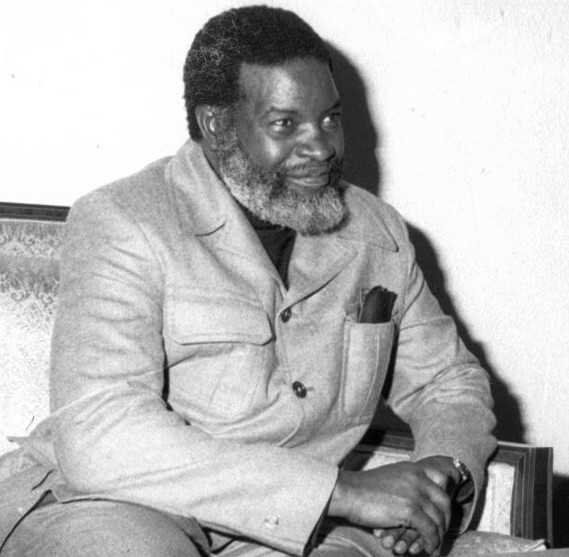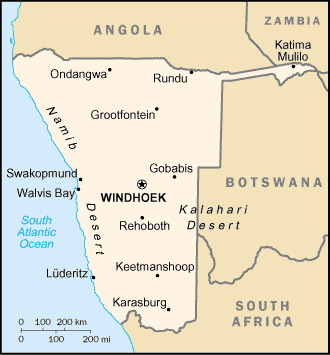|
East Caprivi
East Caprivi or Itenge was a Bantustan and later a non-geographic ethnic-based second-tier authority, the Representative Authority of the Caprivis in South West Africa (present-day Namibia), intended by the apartheid government to be a self-governing homeland for the Masubiya people. Administrative history Bantustan (1972–1980) It was set up in 1972, in the very corner of the Namibian panhandle called the Caprivi Strip. It was granted a self-governing status in 1976. Unlike the other homelands in South West Africa, East Caprivi was administered through the Department of Bantu Administration and Development in Pretoria. Representative authority (1980–1989) Following the Turnhalle Constitutional Conference the system of Bantustans was replaced in 1980 by Representative Authorities which functioned on the basis of ethnicity only and were no longer based on geographically defined areas. Representative Authorities had executive and legislative competencies, being made u ... [...More Info...] [...Related Items...] OR: [Wikipedia] [Google] [Baidu] |
Bantustan
A Bantustan (also known as a Bantu peoples, Bantu homeland, a Black people, black homeland, a Khoisan, black state or simply known as a homeland; ) was a territory that the National Party (South Africa), National Party administration of the Union of South Africa (1910–1961) and later the Republic of South Africa (1961–1994) set aside for People of Indigenous South African Bantu languages, black inhabitants of South Africa and South West Africa (now Namibia), as a part of its policy of apartheid., "1. one of the areas in South Africa where black people lived during the apartheid system; 2. SHOWING DISAPPROVAL any area where people are forced to live without full civil and political rights." The term, first used in the late 1940s, was coined from ''Bantu'' (meaning "people" in some of the Bantu languages) and ''-stan'' (a suffix meaning "land" in Persian language, Persian and other Persian-influenced languages). It subsequently came to be regarded as a disparaging term by s ... [...More Info...] [...Related Items...] OR: [Wikipedia] [Google] [Baidu] |
Caprivi Strip
The Caprivi Strip, also known simply as Caprivi, is a geographic salient protruding from the northeastern corner of Namibia. It is bordered by Botswana to the south and Angola and Zambia to the north. Namibia, Botswana and Zambia meet at a single point at the eastern tip of the Strip, which also comes within of Zimbabwe, thus nearly forming a quadripoint. Botswana and Zambia share a border at the crossing of Kazungula. The territory was acquired in 1890 by German South West Africa in order to provide access to the Zambezi River and consequently a route to the east coast of the continent and German East Africa. The route was later found not to be navigable because of the location of the Victoria Falls, one of the world's largest waterfalls, about east of the Caprivi Strip, and because of more waterfalls downstream such as Kariba Gorge and Cahora Bassa. Within Namibia, the Strip is divided administratively between the Kavango East and Zambezi regions. It is crossed by the ... [...More Info...] [...Related Items...] OR: [Wikipedia] [Google] [Baidu] |
States And Territories Disestablished In 1989
State most commonly refers to: * State (polity), a centralized political organization that regulates law and society within a territory **Sovereign state, a sovereign polity in international law, commonly referred to as a country **Nation state, a state where the majority identify with a single nation (with shared culture or ethnic group) ** Constituent state, a political subdivision of a state ** Federated state, constituent states part of a federation *** U.S. state * State of nature, a concept within philosophy that describes the way humans acted before forming societies or civilizations State may also refer to: Arts, entertainment, and media Literature * '' State Magazine'', a monthly magazine published by the U.S. Department of State * ''The State'' (newspaper), a daily newspaper in Columbia, South Carolina, United States * '' Our State'', a monthly magazine published in North Carolina and formerly called ''The State'' * The State (Larry Niven), a fictional future governme ... [...More Info...] [...Related Items...] OR: [Wikipedia] [Google] [Baidu] |
Bantustans In South West Africa
A Bantustan (also known as a Bantu homeland, a black homeland, a black state or simply known as a homeland; ) was a territory that the National Party administration of the Union of South Africa (1910–1961) and later the Republic of South Africa (1961–1994) set aside for black inhabitants of South Africa and South West Africa (now Namibia), as a part of its policy of apartheid., "1. one of the areas in South Africa where black people lived during the apartheid system; 2. SHOWING DISAPPROVAL any area where people are forced to live without full civil and political rights." The term, first used in the late 1940s, was coined from ''Bantu'' (meaning "people" in some of the Bantu languages) and ''-stan'' (a suffix meaning "land" in Persian and other Persian-influenced languages). It subsequently came to be regarded as a disparaging term by some critics of the apartheid-era government's ''homelands''. The Pretoria government established ten Bantustans in South Africa, and ten ... [...More Info...] [...Related Items...] OR: [Wikipedia] [Google] [Baidu] |
Caprivi Liberation Army
Caprivi Liberation Army (CLA) was a Namibian rebel and separatist group established in 1994 to separate the Caprivi Strip, a region mainly inhabited by the Lozi people. It operates only in the Caprivi strip. Background The Caprivi Strip is located in the far northeast of Namibia. The region is a panhandle of Namibia eastwards about 450 km, between Botswana to the south, Angola and Zambia to the north, and the Kavango Region. During the "Scramble for Africa" period, Great Britain ceded the territory to Germany to access the Zambezi River and reach its other colonies in East Africa while keeping possession of German South-West Africa. The Caprivi strip was of strategic military importance. It saw continual military actions and multiple incursions by various armed forces using the Strip as a corridor to access other territories. Many South African factions mainly handled those military actions during the Rhodesian Bush War (1970–1979). It was also a battlefield for the A ... [...More Info...] [...Related Items...] OR: [Wikipedia] [Google] [Baidu] |
Independence Of Namibia
The South African Border War, also known as the Namibian War of Independence, and sometimes denoted in South Africa as the Angolan Bush War, was a largely asymmetric conflict that occurred in Namibia (then South West Africa), Zambia, and Angola from 26 August 1966 to 21 March 1990. It was fought between the South African Defence Force (SADF) and the People's Liberation Army of Namibia (PLAN), an armed wing of the South West African People's Organisation (SWAPO). The South African Border War was closely intertwined with the Angolan Civil War. Following several years of unsuccessful petitioning through the United Nations and the International Court of Justice for Namibian independence from South Africa, SWAPO formed the PLAN in 1962 with material assistance from the Soviet Union, China, and sympathetic African states such as Tanzania, Ghana, and Algeria. Fighting broke out between PLAN and the South African security forces in August 1966. Between 1975 and 1988, the SADF staged m ... [...More Info...] [...Related Items...] OR: [Wikipedia] [Google] [Baidu] |
Turnhalle Constitutional Conference
The Turnhalle Constitutional Conference was a conference held in Windhoek Windhoek (; ; ) is the capital and largest city of Namibia. It is located in central Namibia in the Khomas Highland plateau area, at around above sea level, almost exactly at the country's geographical centre. The population of Windhoek, which ... between 1975 and 1977, tasked with the development of a constitution for a self-governed South West Africa (Namibia) under South African control. Sponsored by the South African government, the Turnhalle Conference laid the framework for the government of South West Africa from 1977 to Namibian War of Independence, independence in 1989. The conference was held in defiance of the 1972 United Nations General Assembly decision to recognise the SWAPO, South West Africa People's Organization (SWAPO) as "sole legitimate representative" of Namibia's people. Consequently, SWAPO, as well as other political groups rejecting apartheid, did not participate, and the UN re ... [...More Info...] [...Related Items...] OR: [Wikipedia] [Google] [Baidu] |
Minister Of Bantu Administration And Development, And Bantu Education
The minister of Bantu administration and development, and Bantu education is a former political position in apartheid South Africa South Africa, officially the Republic of South Africa (RSA), is the Southern Africa, southernmost country in Africa. Its Provinces of South Africa, nine provinces are bounded to the south by of coastline that stretches along the Atlantic O .... Until 1958, the position was titled the minister of native affairs. Office-holders {, class="wikitable" ! Name ! Period ! Title , - , Michiel Daniel Christiaan de Wet Nel , 1958–1966 , ''Minister of Bantu Administration and Development, and Bantu Education'' , - , Michiel Coenraad Botha , 1966–1977 , ''Minister of Bantu Administration and Development, and Bantu Education'' , - , Cornelius Petrus Mulder , January – November 1978 , ''Minister of Plural Relations and Development'' , - , Piet Koornhof , 1978–1984 , ''Minister of Plural Relations and Development''/''Minister of Co-operat ... [...More Info...] [...Related Items...] OR: [Wikipedia] [Google] [Baidu] |
Self-governing
Self-governance, self-government, self-sovereignty or self-rule is the ability of a person or group to exercise all necessary functions of regulation without intervention from an external authority. It may refer to personal conduct or to any form of institution, such as family units, social groups, affinity groups, legal bodies, industry bodies, religions, and political entities of various degrees. Self-governance is closely related to various philosophical and socio-political concepts such as autonomy, independence, self-control, self-discipline, and sovereignty. In the context of nation states, self-governance is called national sovereignty which is an important concept in international law. In the context of administrative division, a self-governing territory is called an autonomous region. Self-governance is also associated with political contexts in which a population or demographic becomes independent from colonial rule, absolute government, absolute monarchy, ... [...More Info...] [...Related Items...] OR: [Wikipedia] [Google] [Baidu] |
Salient (geography)
A salient, panhandle, or bootheel is an elongated protrusion of a geopolitical entity, such as a subnational entity or a sovereign state. While similar to a peninsula in shape, a salient is most often not surrounded by water on three sides. Instead, it has a land border on at least two sides and extends from the larger geographical body of the administrative unit. In American English, the term panhandle is often used to describe a relatively long and narrow salient, such as the westernmost extensions of Florida Panhandle, Florida and Oklahoma Panhandle, Oklahoma, or the northernmost portion of Idaho Panhandle, Idaho. Another term is bootheel, used for the Missouri Bootheel and New Mexico Bootheel areas. Origin The term ''salient'' is derived from salient (military), military salients. The term "panhandle" derives from the analogous part of a cooking pan, and its use is generally confined to North America. The salient shape can be the result of arbitrarily drawn international ... [...More Info...] [...Related Items...] OR: [Wikipedia] [Google] [Baidu] |
Odendaal Plan
Frans Hendrik Odendaal (1898–1966) (known as Fox Odendaal) was a South African politician, administrator of the Transvaal province, best remembered for heading the commission that became known by his last name. Odendaal Commission In 1962 Odendaal was appointed as head of the officially named "Commission of Enquiry into South-West Africa Affairs." Over time the commission came to be popularly called the "Odendaal Commission". The Commission finished its enquiry towards the end of 1963, but its findings were formally handed early in 1964. The Odendaal Report, as it was called, contained a series of proposals (The Odendaal Plan) regarding the establishment of territories dedicated to the "separate development" of the different ethnic groups in South-West Africa (Namibia today). The Odendaal Plan thoroughly described the different steps needed to establish in South-West Africa bantustans similar to those already in South Africa. The report was first rejected by the Special Committ ... [...More Info...] [...Related Items...] OR: [Wikipedia] [Google] [Baidu] |



